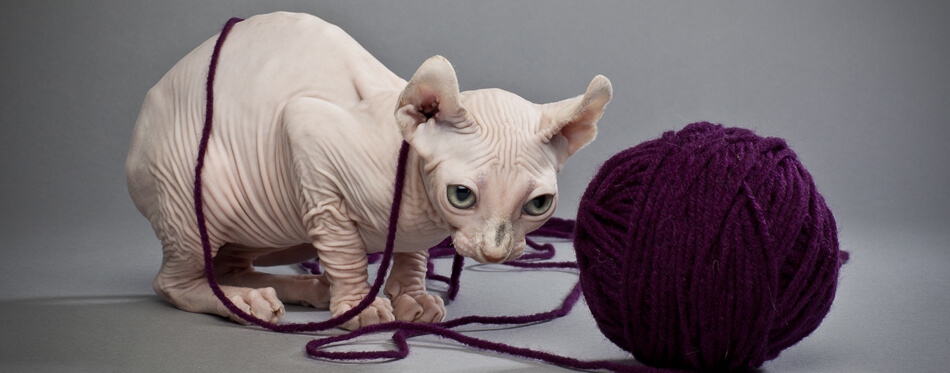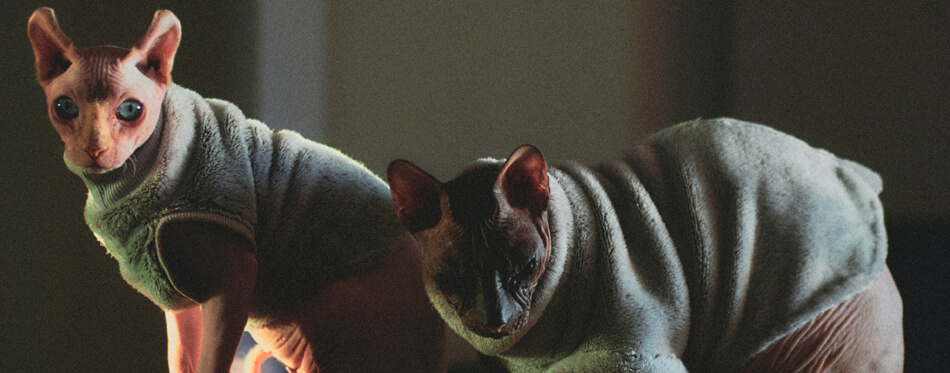Though the Elf cat is still a relatively new cat breed, there’s a decent amount of information out there already. The beauty of new breeds of cats and dogs is that it’s much easier to spread information about them than ever before. Elf kittens are created by crossing American Curl cats and Sphynx breed cats – this cross creates the Elf hybrid breed; a hairless cat with curled ears.
The International Cat Association currently recognizes 73 breeds of cat for their shows and competitions. Unfortunately, the extremely rare breed that is the Elf cat has not made that list yet, though both of the parent cat breeds (the American Curl and the Sphynx) are recognized. This is because the Internation Cat Association does not acknowledge the Elf cat as its own breed yet, and believes that the breed is still in its developmental stage as a hybrid cat, rather than a pedigree cat breed.
An Overview of the Elf Cat
- Breed type: Crossbreed
- Height: 9 to 12 inches
- Weight: 10 to 15 pounds
- Coat colors: Any, with any pattern
- Personality: Playful, friendly, affectionate
- Lifespan: 8 to 14 years

History of the Elf Cat
Bred in 2004 by Karen Nelson and Kristen Leedom in the United States of America, the Elf cat is a hybrid cat. These two individuals bred an Elf kitten into existence by pairing together an American Curl and a Sphynx cat. Karen Nelson and Kristen Leedom wanted to use these parent breeds so that the new breed of Elf kitten would retain the loving personality of the Sphynx, while hopefully gaining the genetics that gives American Curls their unique ear shape.
Their breeding experiment was successful and resulted in the Elf hairless cat which has been around for less than 20 years so far. There are other breeders who have taken up breeding Sphynx cats and American Curls to get the same results as Nelson and Leedom – for example, the breeders who run No Coat Kitty, using their combined knowledge of Sphynx cats to breed healthy pets with as few health conditions as possible. These breeders have a very different approach to backyard breeders, who just try to make a quick buck by breeding the standard Elf cat.
Of course, a new breed benefits from new traits and has a set of their own most distinctive features for humans to be able to identify them properly. For Elf cats, one new trait was the small amount of fur on their otherwise hairless bodies. Though Sphynx cats are completely hairless, Elf cats may have some fine hair covering their skin. However, the fur is so fine that the standard Elf appears to be as hairless as the Sphynx that half of its genetics comes from.
They are marvelous cats with very similar bodies to the average Sphynx. They share the Sphynx’s athletic body and head shape, while the experimental breed has taken on the curled tips that American Curl cats have on their ears.
The cats have been around long enough now that they have been shown at competitions run by the International Cat Association (TICA). But they are shown as a variant of Sphynx cat, rather than being recognized as their own breed. As a hybrid cat with the broad gene pool of an American Curl and a Sphynx, the Elf should probably have its own category.
Quick Facts About the Elf Cat
The Elf benefitted by inheriting the extremely sociable disposition of the Sphynx part of their genetics, alongside the gentle nature of the American Curl part of their parentage. Hairless cats aren’t as popular as other cat breeds, so they need to have positive personalities to seem appealing to potential pet owners looking to adopt. It’s a shame, but it’s the truth of the matter. When people want to buy or adopt a cat, they rarely think of hairless cats first, and an aggressive hairless cat is going to have a hard time finding a home.
There are great benefits to owning hairless cats, though! Though there are no true hypoallergenic cats or dogs, the Elf cat is less likely to set off pet allergies in someone who knows that they are allergic to pet fur or pollen (because pollen usually gets trapped in a cat’s fur, which is what sets off hayfever-like allergy reactions). The Elf cat is practically hairless, and there are certainly cats of the breed out there that don’t carry the fine hair that others do.
Elf cats are extremely rare hybrid cat breeds. One of the reasons they haven’t been fully accepted in the Cat Association is because there aren’t enough of them around. TICA only just started letting Elf cat owners show their cats in competitions at all, even if they are in the Sphynx category.
(size, hypoallergenic or not, are they rare, etc)
Fun fact: Like American Curl cats, the Elf’s curled ears are always curled backwards (this was originally caused by a spontaneous mutation for the American Curl breed). They also have no ear furnishings!
Things You Should Know About the Elf Cat
Elf cats love getting human attention. They have the same personality of both of their parent cats, which has led to domestic cats with gentle, loving natures. The wonderful Elf takes after both the Sphynx and the American Curl with its affectionate tendencies, and their ability to quickly adapt to a new home life. Any owner, provided they show their cat enough love and care, will be able to gain acceptance from their Elf Sphynx cat in no time at all.
The genetic diversity of the Elf cat has given us a hairless cat that can come in a huge range of colors and patterns. Their lack of a coat makes them an excellent cat to have indoors for long periods of time. Their personality and lack of fur makes them better suited as a full-time indoor cat, though they may be able to spend small periods of time outdoors with supervision – perhaps a catio would be a good solution for your hairless feline friend.
As pets, these sweet-tempered Elf breed cats are certainly perfect for homes with young children and other pets. That’s great news for cat enthusiasts that have other cats at home but want to introduce an Elf cat into the mix. Who can resist those amazing curled ears, after all?
Elf Cat Appearance
Body type
Elf cats share many of their physical characteristics with their Sphynx parents. The prominent cheek bones, prominent whisker pads, delicate skin, and the smooth arc of their ears. Their appearance is only slightly different because of the American Curl genetics that they have. These other genetics cause their smooth ears to curl backwards cutely, and for their body to have a dusting of fine fur over in.
The reality is that the Elf cat is so close to the breed standard for a Sphynx cat that they are considered only a modification of the original breed, rather than their own hybrid breed.
Coat colors and patterns
There are no specific skin or fur colors for this hybrid breed, nor are there any common patterns for breeders or owners to look for. The breed is still relatively new, so this may change over time, but there’s no true breed standard for your Elf cat to try and adhere to.
When the Elf cat has their own breed category and isn’t as rare as it is now, this is likely to change. Until then, TICA sees the Elf cat as a variant Sphynx cat and little more.
Eye colors
Similar to coat colors, the Elf cat doesn’t have any set eye colors. However, there have been Elf cats will eye colors ranging from gold to green and everything in between!
It’s said that pointed Elf cats should have blue eyes because of the mutation that messes with their melanin production, but again, there’s no breed standard for the Elf cat.
Health, Care, and Grooming Your Elf Cat
How Much Food Does an Elf Cat Need?
For guidance on feeding your Elf cat, it’s best to look at the same information given for Sphynx cats because their body type is the same.
Hairless cats need a higher intake of calories than other breeds because they use those calories to make energy that keeps them warm. It’s a good idea to feed a hairless cat breed around 5% of their body weight each day. The average weight of an Elf is 10 to 15 pounds, so a 10-pound hairless feline would need around 0.5lbs or 226 grams of food (that’s approximately one cup of dry food).
If you find that your pet is gaining or losing weight, adjust the amount of food that you’re feeding them. Be sure to feed them a high-quality diet.
Health Conditions
Elfs are prone to the same health issues that all hairless felines are. These include:
- Sunburn
- Sensitivity to hot and cold weather
- Sensitivity to sudden temperature changes
- Delicate skin (meaning their skin can be easily damaged or injured)
The Sphynx is also known for developing Hypertrophic Cardiomyopathy, which is a cardiac condition where the muscle of the heart becomes strangely thick and prevents the heart from functioning correctly.
With hybrid cats, it’s always best to look into the health conditions of both breeds from the genetic pool that created the hybrid.
Grooming Needs
Despite their lack of fur, the Elf cat does have specific grooming needs that their owner needs to help them meet. They are low-maintenance as far as felines are concerned, but regular grooming should be a part of their routine to prevent build-up on their skin.
Pet owners can do this by wiping down their Elf with a soft cloth or adding baths into their routine. Hairless cats often end up with skin issues due to poor grooming.
Elf Cat Temperament
As mentioned, the Elf is an extremely friendly and affectionate cat. They are known for being sociable, and they can be placed in households with other cats and households that have young children. In terms of temperament, the Elf is much like the Sphynx. As long as you spend time with them, they will be your best friend.

What is the Average Price of an Elf Cat?
Considering their rarity, it’s no surprise that the Elf is an expensive breed to purchase. If you’re looking to buy a kitten of this breed from a reputable breeder, you’re looking at spending around $2000.
When searching for an Elf, avoid marketplaces, backyard breeders, and people asking for deposits online. Always see the cats in person, ask for veterinary records, and pay when you’re ready to take your Elf home.
Alternatively, why not check your local shelter for another hairless breed that could fill the same hole in your heart? Hairless breeds often need rehoming, and the only major visible difference between a Sphynx and an Elf is their ears.
An Elf is a wonderful feline to invite into your home, and they truly got some amazing traits from both lines of their breed parentage. But if you’re in the market for a kitten that isn’t as costly, there are many other alternative breeds that could be seeking a new home at your local shelter.

